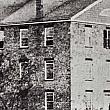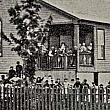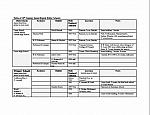
Keeping up with Kids
by Diana Barrett
John Ball reported that school population in 1856 was 760; by 1868, “The school census just taken shows 2,931 scholars between the ages of 5 and 20 years, being an increase of 486 in the past year. There is no doubt that this increase, by immigration and otherwise, will continue for some years.”[1]
And E.A. Strong concluded his 1868 Superintendent’s Report with a look to the future,
“While we congratulate ourselves upon the [completion of the new Central School] let us not forget that our schools have barely kept pace with the material and social advancement of the people, and that our progress in wealth and population are so rapid that great diligence will always be required to keep the schools upon a level with the physical condition of our population.”
That same year an article in the Daily Eagle disparaged the ward schools, as looking “more like old barns than proper places for the education of our children. They are unsightly, ill-arranged, miserable old rookeries. The city ought to be ashamed of them, as we are sure every citizen is.”[2] This may be the reason Baxter, for many years editor of the Daily Eagle, never mentioned them in his venerable 1891 history of the city.
The four ward schools had relieved the crowding at District No. 1 Union School, but by the fall of 1865 the South Division St. School could no longer accommodate the growing number of students. A solution was found when the building was raised, and a basement room was built beneath the original structure, at a cost of $500; just the first of countless school additions throughout the growing city.[3]
An example of ingenuity by the frugal school board, while trying to keep up with an exploding population that doubled every ten years, occurred when a new three-story brick building—William G. Robinson, architect—replaced Fountain St. School in 1872. The original 1858 wooden ward school was then moved to the NW corner of Spring St. (Commerce Ave.) and Goodrich to relieve the congestion at South Division St. School, which had already outgrown the basement room added in 1865.[4]
Ten years later, when even more space was needed at South Division, a two story wooden building with a brick basement was constructed at the rear of the lot on the east side of Spring St.[5] The old wooden Fountain St. Ward School which had been moved to Spring St. and Goodrich, was then sold to John McConnell, owner of the property.
Between 1865 and 1872 three of the wooden ward schools were replaced with new brick buildings: North Division St., Fountain St., and Wealthy St. In District No. 2 on the West Side the old, wooden Turner School, was replaced by one of brick in 1874. Jefferson St. School (not to be confused with Jefferson Avenue), new in 1870, was also built of brick.
Replacement of the South Division St. School was long overdue as noted by the president of the school board in the 1879-80 Annual Report, “It is a disgrace to this Board and to the city, and I trust that at an early date you will take some action toward the erection of a suitable building.” It had also been noted earlier in the 1874-75 Annual Report, “A new and commodious school edifice will be demanded before long to take the place of the present buildings on this lot.”[6]
The Grand Rapids Board of Education, was formed in 1871 when the Districts No.1, No. 2, and No. 6 (Coldbrook) were consolidated. One of the first decisions of the newly established Board was to clarify the names of the schools. District No. 1 Union School on the east side of the Grand River officially became Central School, housing high school, grammar, and intermediate students; primary schools were to be numbered one through twelve. Former District No. 2 Union School on the west side of the river remained Union School, for grammar, intermediate and primary students. The only building in District No. 6 became Coldbrook School for intermediate and primary pupils.
The Grand Rapids school system now boasted eleven schools: seven from the East Side—Central School and six primary schools; three from the West Side—the 1855 stone school, the old wooden Turner primary school, and newly built Jefferson St. School; and one from the Coldbrook District.
[1] GR Eagle, 9/8/1868
[2] GR Eagle, 4/11/1868 (Possibly Baxter is the author?)
[3] GR Eagle, Sep 5, 1865
[4] Bd. Of Ed. 1873 Annual Report
[5] Bd. of Ed. Minutes, Sep 7, 1874, pg 252
[6] Bd. of Ed. Annual Report 1874-75

 facebook
facebook














